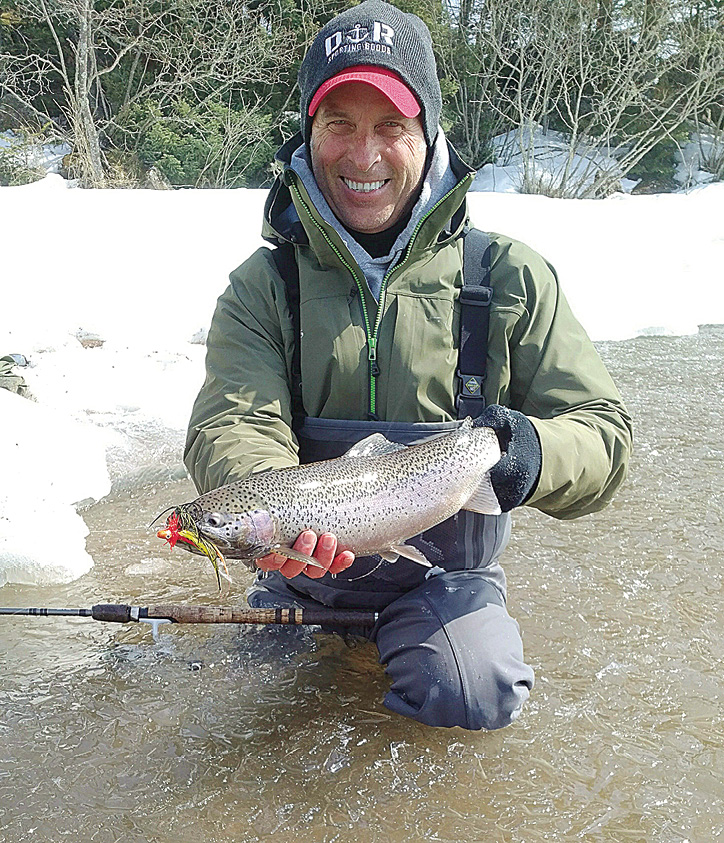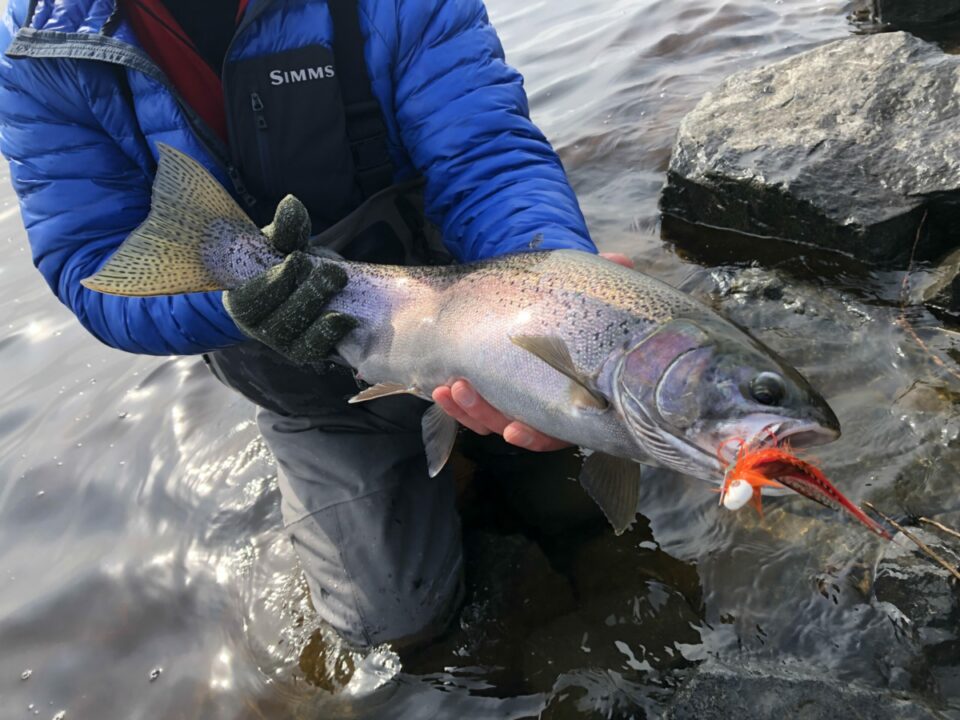It had already been a fine fishing trip and the outing had only just begun. On the third cast I had managed to land one nice silver steelhead. A hen of about 6 pounds had smacked the lure and did a semi-jump, despite the ice-cold water. That fish was slipped back into the lake and swam off as if nothing had happened, yet things were about to get even better.
My father, Gordon Sr., was about 50 yards away blasting a Kamlooper spoon way out in the lake. I was casting a clown-coloured Husky Jerk and I had to make sure my line fell between a few massive ice chunks that were floating around. We were fishing Lake Superior in April, and there was still some evidence that the winter ice wasn’t ready to leave.
I carefully waded back out to the spot I’d been casting from. The water was just above knee depth, and I planted my feet firmly before casting—a slip would be very cold and uncomfortable. The rod went back and the crankbait went flying. It landed with a splat between a couple of ice floes and the reel was engaged. Popping the rod tip down to the water, I slowly and deliberately worked the lure back. The line stopped as a big steelhead grabbed the Rapala.
“There’s one Senior,” I said, while lifting the rod overhead.
“On my way,” he said, reeling up his line.
The trout was fighting hard but lacked the speed of the first trout. When it got closer, I could see it was a big, dark rainbow. There was no net, so I began to walk the fish toward shallower water were it would be gloved.

“Looks pretty nice son,” said Senior.
The trout swam by and I grabbed it by the wrist of the tail. Barely.
“How big is that thing?” said my dad.
“Not sure,” I replied. “Let’s measure it.”
A minute later we pulled out the tape as the trout lay on a flat rock. It read 33 inches. A monster and my personal best. After a few quick pictures, the trout was released.
“You don’t see those every day,” I said, as the enormous trout swam off.
Ice-out trout and steelhead aren’t always that big. Yet, it’s amazing how often nice fish are caught in the coldest water. Let’s look at how to fish ice-out trout.
Ice-Out Locations
On Lake Superior, any open water has the potential to cough up a steelhead, laker, salmon, coaster brook trout or even a stray brown trout. Remember that in Ontario, brook trout are not open until Saturday, April 22, and there is a size limit of one fish over 22 inches. The places that trout congregate tend to be associated with rivers or creeks. However, that doesn’t mean you have to fish right at the mouth of the tributary; any point, break-wall or island will be worth a shot. If you can fish from a canoe, kayak or boat, you will be able to cover much more area. However, the shore casting angler can do very well at ice-out as well. Make sure you have insulated waders and are properly dressed. Also, don’t shore fish alone.
Fishing from shore on stocked, inland lakes can also be very good. As soon as the ice starts pulling away from the shore, stocked brook trout, rainbow trout, splake and browns will start patrolling the shallows, looking for food. Casting from shore is an excellent way to get these fish. Timing is everything, but if you can get to a lake at ice-out on a bright, sunny day, the fish will often be the most active. The sun warms the water and the fish get hungry. On inland lakes, trees that have fallen in the water, beaver dams or beaver houses are all fish magnets. The sticks and logs provide great places for minnows, leeches, newts and nymphs to hide, which are what trout like to eat.
What To Use
At ice-out, lures that are easy to cast and look like something good to eat get the nod. As mentioned, crankbaits that look like minnows, smelt or other baitfish are very effective. Trout are hungry after a long winter and a potential meal of meat is hard to pass up. The Rapala Husky Jerk is a good choice as is the Live Target Smelt. Go smaller on inland lakes but used 4- to 5-inch crankbaits on Superior.
Another very popular option for casting is the spoon. There are many good ones, but the EGB, Little Cleo, Krocodile and Nipigon Spoon are all worth a try. Think silver, silver/blue or brass spoons on Superior. On inland lakes, I like fire tiger, silver/orange and brass/red spoons. Throwing heavier weight spoons of 3/8- or 5/8-ounces will help you punch through the wind on Lake Superior. On smaller lakes, a one quarter or 3/8-ounce spoon should do the job. Use a metal clip on your main line as it will be easier to change out lures quickly.

My final lure choice is one that has been the most consistent for me. I find bucktail jigs—or jig flies—to be very effective on cold water trout and salmon. My favourites are made by Mighty Mitch and Jungle Joe’s Jig flies of Thunder Bay. You can find them on Facebook or Instagram. The brightly coloured jig flies have been quite good in cold water, but I tend to start with black, brown or smelt coloured jig flies. Cast them out, then retrieve them back just fast enough so that they are not touching bottom. Trout and salmon really pop them, and often will hit a jig fly when nothing else works.
Ice-out trout fishing is just around the corner. If you want to get a jump on the open water season, now is the time to bust out the rod and get fishing.




